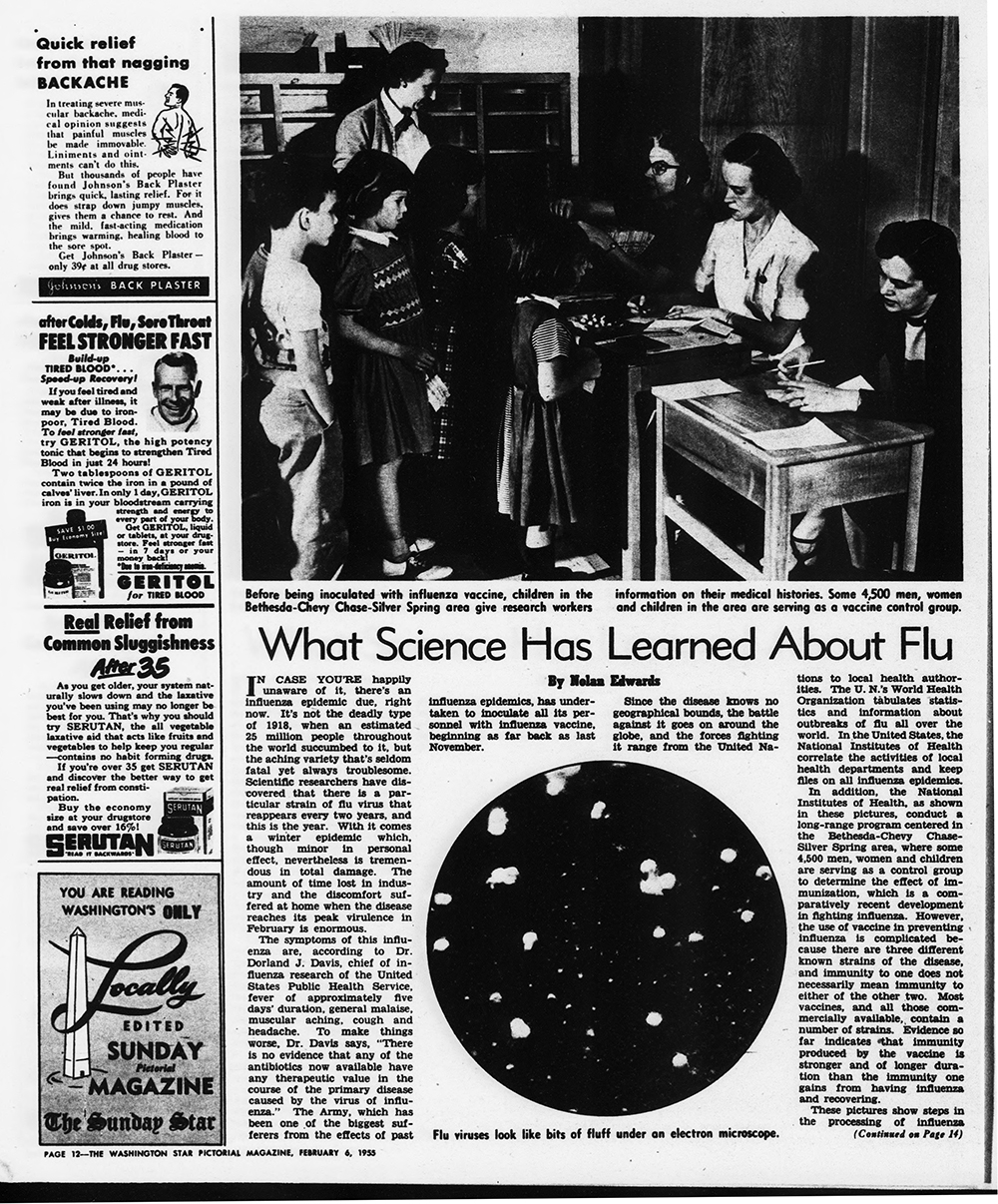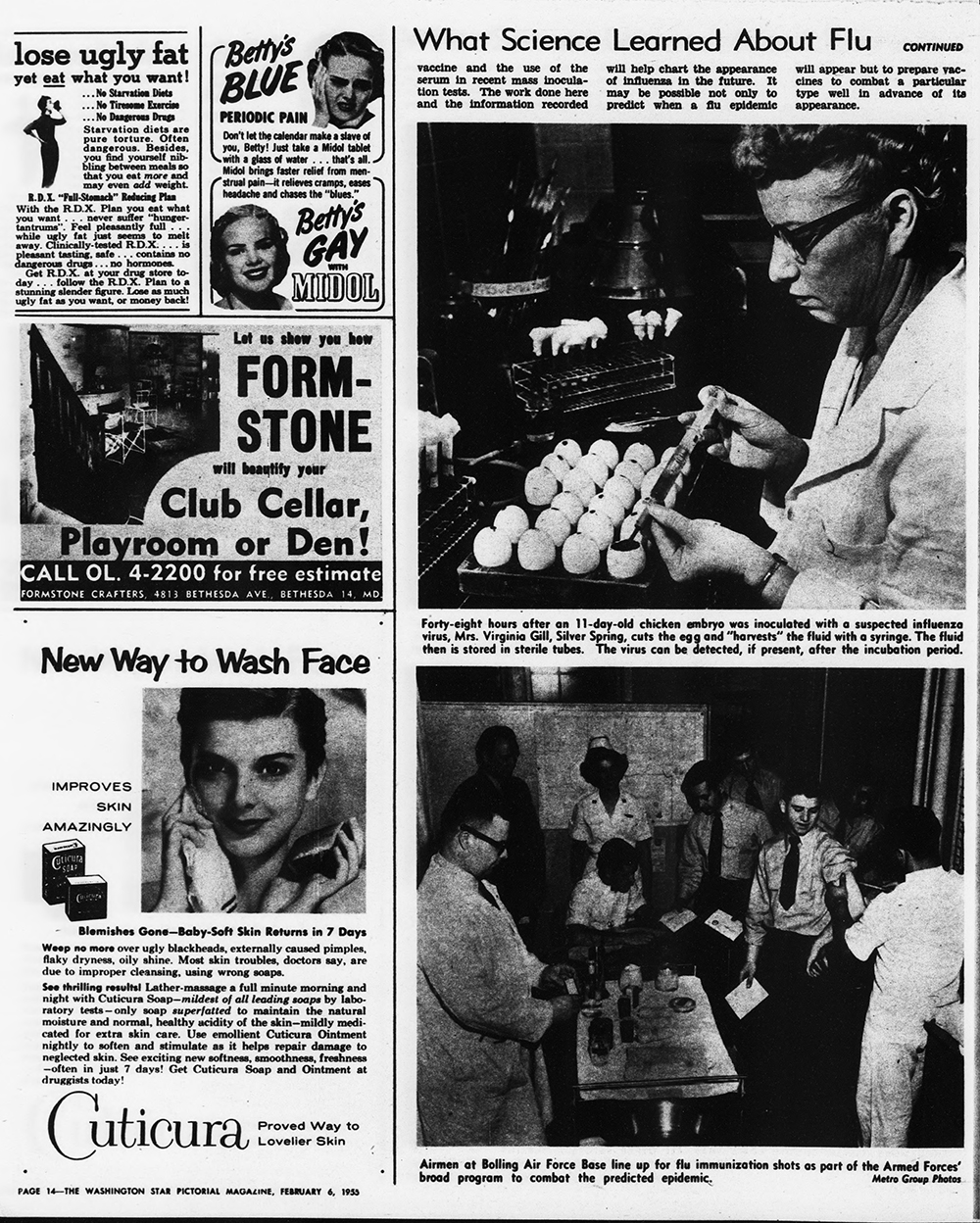Right to the Source
Looking Back at a Pandemic and Preparing for the Next One
The Science Teacher—July/August 2021 (Volume 88, Issue 6)
By Stephen Wesson
“In case you’re happily unaware of it, there’s an influenza epidemic due, right now.” An article from the magazine supplement of the Washington Star newspaper begins with a stern warning. The article’s next sentence, though, seems more reassuring: “It’s not the deadly type of 1918, when an estimated 25 million people throughout the world succumbed to it, but the aching variety that’s seldom fatal yet always troublesome.”
This article, “What Science Has Learned About Flu,” was published in 1955, more than three decades after the flu pandemic of 1918. However, that global catastrophe and its staggering death toll were still well within living memory, and many of the medical interventions and public health strategies described in the article were developed in response to the 1918 flu or in its aftermath. A close look at this article can provide students with insights into what it was like to look back at a deadly pandemic while planning for the challenges of the future.

One key breakthrough in the battle against the flu is given a prominent place in this article: an image of “flu viruses” as seen through an electron microscope. In 1918, as the pandemic raged, it was widely believed that influenza was a bacterial infection. When human influenza virus was isolated in the 1930s, it dispelled this belief and paved the way for vaccine development in the late 1930s and 1940s, as well as fueling new work in virology, immunology, and many other fields.

Many of the new tools described in the article, though, were institutional in nature. The article mentions the efforts of the World Health Organization (WHO) and the National Institutes of Health (NIH) to collect and analyze data on influenza outbreaks, as well as an NIH vaccine study and a program undertaken by the U.S. Army to vaccinate all its personnel. In 1918, there were no systems in place for gathering information on flu activity on a large scale, but the League of Nations, founded in 1919, moved quickly to establish an international health organization, helping to build the foundation for internationally coordinated responses to diseases and other public health threats.
The article’s warning of an impending epidemic was a timely one. In 1957, a new influenza strain spread around the world, eventually taking the lives of more than one million people. This time, scientists recognized the pandemic quickly and were able to develop a vaccine for distribution on a large scale. Perhaps as importantly, the organizations and practices that emerged in the wake of the 1918 influenza pandemic made it possible for scientists and public health officials to study the 1957 strain and its effects more thoroughly than ever before, and to better prepare for pandemics yet to come.
About the Source
The article featured here can be found in Chronicling America (https://chroniclingamerica.loc.gov), a digital database of historical newspapers developed and supported through a partnership between the Library of Congress and the National Endowment for the Humanities. Direct links to its two pages are: https://chroniclingamerica.loc.gov/lccn/sn83045462/1955-02-06/ed-1/seq-159/ and https://chroniclingamerica.loc.gov/lccn/sn83045462/1955-02-06/ed-1/seq-161/.
Additional articles related to the 1918 and 1957 influenza pandemics are also available. Suggested search terms include: “influenza” or “flu,” and narrowing your search to the appropriate span of years.
Your students may also wish to explore these other related resources from the Library of Congress:
- “Influenza Epidemic of 1918 (Spanish Flu): Topics in Chronicling America”: https://guides.loc.gov/chronicling-america-spanish-flu
- “’This malignancy, it was right at our very doors.’ Using Manuscripts to Study the Influenza Pandemic of 1918” (May 2020, Teaching with the Library of Congress blog): https://blogs.loc.gov/teachers/2020/05/this-malignancy-it-was-right-at-our-very-doors-using-manuscripts-to-study-the-influenza-pandemic-of-1918/
- “Pandemic and Civic Virtue: The American Red Cross and the Influenza Pandemic of 1918” (March 2020, Teaching with the Library of Congress blog): https://blogs.loc.gov/teachers/2020/03/pandemic-and-civic-virtue-the-american-red-cross-and-the-influenza-pandemic-of-1918/
- Responses to COVID-19 in the United States, resources compiled by the Law Library of the Library of Congress: https://www.loc.gov/law/help/covid-19-responses/us
- Recordings of COVID-related programs hosted by the Library of Congress: https://www.loc.gov/film-and-videos/?q=COVID.
Stephen Wesson (swesson@loc.gov) is an educational resources specialist at the Library of Congress.
General Science Instructional Materials Literacy High School


